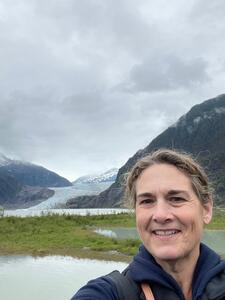
Janet Brownell has been a passionate educator for 27 years, teaching everything from chemistry to engineering in rural school districts. Today, she works as an educational technology coach, helping bring computer science (CS) education to teachers and students in the rural communities of Butte County, California. Her journey into computer science began much earlier than most, blending her background in science with a natural affinity for technology.
Janet Brownell: My first real introduction to CS was in high school, where I took a class called "CABOL (Computer Assisted Business Operations Lab) Computer Assisted Business Operations Lab," thanks to my mom’s encouragement. I learned basic tech tools like word processors, spreadsheets, and databases—skills that helped me get office jobs instead of fast food gigs. In college, I found myself using technology in my science courses, writing scripts and analyzing data with spreadsheets. I didn’t realize at the time, but I was already practicing what we now call "computational thinking."
Janet Brownell: I didn’t set out to teach computer science, but I’ve always embraced tech in the classroom. Early in my career, I was one of the first teachers in my district to have Chromebooks. I started teaching kids how to use technology as a tool for problem-solving in science, engineering, and even in their everyday lives. Later, I had the chance to teach an engineering class that included computer science principles, which was a real eye-opener. We used coding to design systems for aeronautical engineering projects—bringing together science, math, and coding.
Janet Brownell: The biggest challenge in my rural community was the lack of resources. There wasn’t much access to home computing, and kids didn’t always see the value in learning computer science. When I introduced the Hour of Code, not all students showed interest, but the kids who struggled academically really thrived. They felt empowered in a way they never had before. It was a hard sell at first, but seeing those kids light up was all the encouragement I needed to keep pushing for more CS in my classroom.
Janet Brownell: What excites me about CS is its ability to teach problem-solving in so many different contexts. Whether it’s solving a complex science problem or just teaching kids how to use a spreadsheet to organize data, it’s about breaking down a problem and thinking critically. There’s always more than one way to get to a solution, and I love showing my students that.
Janet Brownell: Moving into educational technology coaching allowed me to help other teachers bring CS into their classrooms. What I’m doing now is less about teaching students directly and more about showing teachers how to integrate CS principles into all subjects. I’ve realized that many teachers are already teaching computational thinking without even knowing it. My role now is to help them see how their existing lessons already align with CS, so they can give their students the skills they’ll need for the future.
Janet Brownell: CS is a foundational skill for the future. It’s not just for tech jobs; it’s about critical thinking, problem-solving, and creativity. Kids need to understand that learning CS isn’t just about writing code—it’s about learning how to approach and solve problems in new ways. I truly believe CS is a new literacy that every student should have, no matter where they live or what career they want to pursue.
Janet Brownell: Start small. You don’t need to be a CS expert to bring it into your classroom. Think about what you’re already teaching and look for places where you’re already using computational thinking. Whether it’s data analysis in science or organizing information in history, there are CS principles that can fit into almost any subject. The key is to make those connections explicit to your students, so they understand that they’re learning valuable skills for the future. And of course, don’t be afraid to just try something new! Just remember, it’s not about being perfect—it’s about learning how to think differently and approach challenges from new angles.